buttons MERCEDES-BENZ B-CLASS HATCHBACK 2014 Owners Manual
[x] Cancel search | Manufacturer: MERCEDES-BENZ, Model Year: 2014, Model line: B-CLASS HATCHBACK, Model: MERCEDES-BENZ B-CLASS HATCHBACK 2014Pages: 405, PDF Size: 12.24 MB
Page 9 of 405
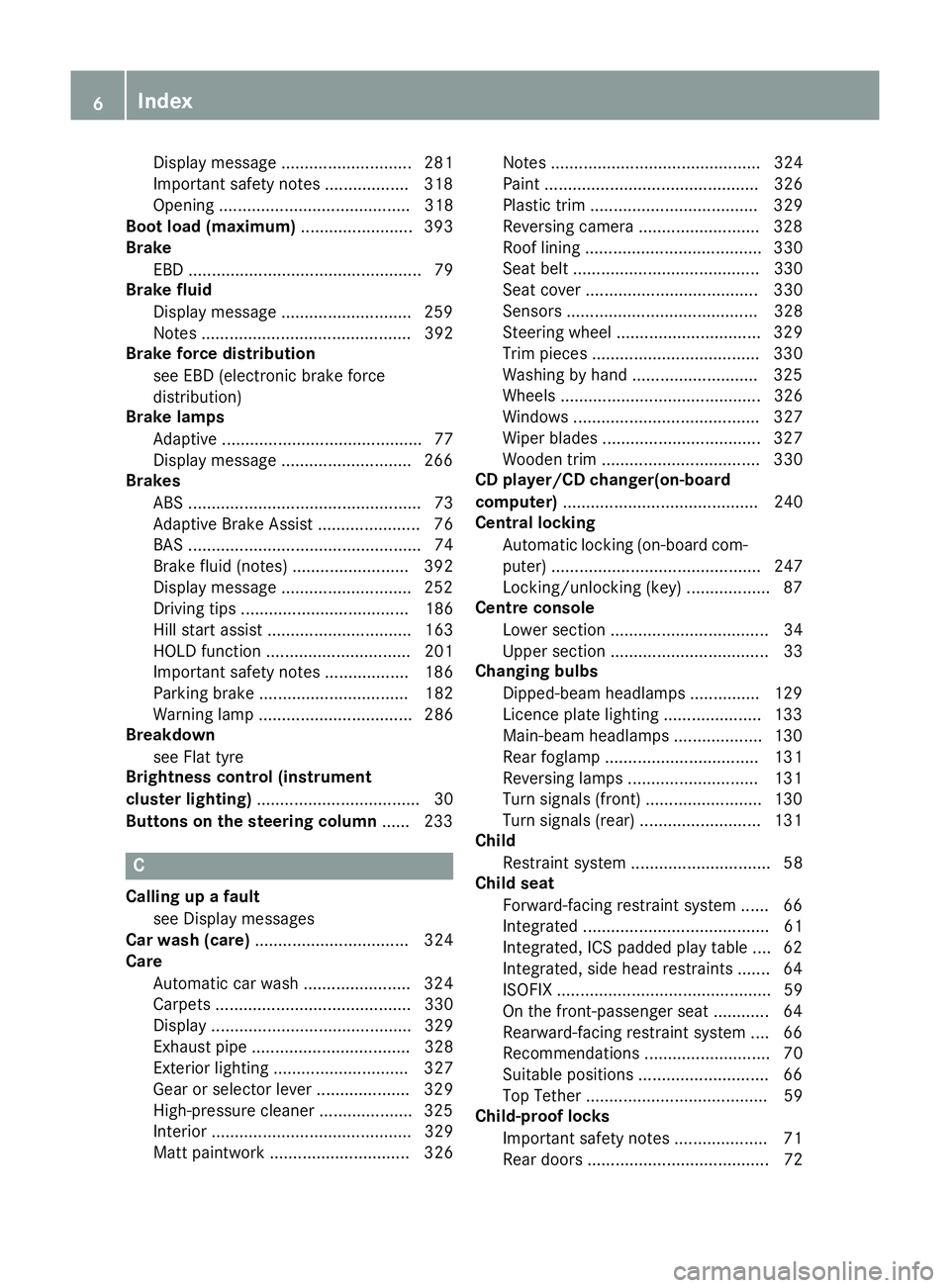
Display message ............................ 281
Important safety note s.................. 318
Opening ......................................... 318
Boot load (maximum) ........................ 393
Brake
EBD .................................................. 79
Brake fluid
Display message ............................ 259
Notes ............................................. 392
Brake force distribution
see EBD (electronic brake force
distribution)
Brake lamps
Adaptive ........................................... 77
Display message ............................ 266
Brakes
ABS .................................................. 73
Adaptive Brake Assist ...................... 76
BAS .................................................. 74
Brake fluid (notes) ......................... 392
Display message ............................ 252
Driving tips .................................... 186
Hill start assist ............................... 163
HOLD function ............................... 201
Important safety notes .................. 186
Parking brake ................................ 182
Warning lamp ................................. 286
Breakdown
see Flat tyre
Brightness control (instrument
cluster lighting) ................................... 30
Buttons on the steering column ...... 233C
Calling up a fault see Display messages
Car wash (care) ................................. 324
Care
Automatic car wash ....................... 324
Carpets .......................................... 330
Display ........................................... 329
Exhaust pipe .................................. 328
Exterior lighting ............................. 327
Gear or selector lever .................... 329
High-pressure cleaner .................... 325
Interior ........................................... 329
Matt paintwork .............................. 326 Note
s............................................. 324
Paint .............................................. 326
Plastic trim .................................... 329
Reversing camera .......................... 328
Roof lining ...................................... 330
Seat belt ........................................ 330
Seat cove r..................................... 330
Sensors ......................................... 328
Steering wheel ............................... 329
Trim pieces .................................... 330
Washing by hand ........................... 325
Wheels ........................................... 326
Windows ........................................ 327
Wiper blades .................................. 327
Wooden trim .................................. 330
CD player/CD changer(on-board
computer) .......................................... 240
Central locking
Automatic locking (on-board com-puter) ............................................. 247
Locking/unlocking (key) .................. 87
Centre console
Lower section .................................. 34
Upper section .................................. 33
Changing bulbs
Dipped-beam headlamp s............... 129
Licence plate lighting ..................... 133
Main-beam headlamp s................... 130
Rear foglamp ................................. 131
Reversing lamps ............................ 131
Turn signals (front) ......................... 130
Turn signals (rear) .......................... 131
Child
Restraint system .............................. 58
Child seat
Forward-facing restraint system ...... 66
Integrated ........................................ 61
Integrated, ICS padded play table .... 62
Integrated, side head restraints ....... 64
ISOFIX .............................................. 59
On the front-passenger seat ............ 64
Rearward-facing restraint system .... 66
Recommendations ........................... 70
Suitable positions ............................ 66
Top Tether ....................................... 59
Child-proof locks
Important safety notes .................... 71
Rear doors ....................................... 72 6
Index
Page 20 of 405
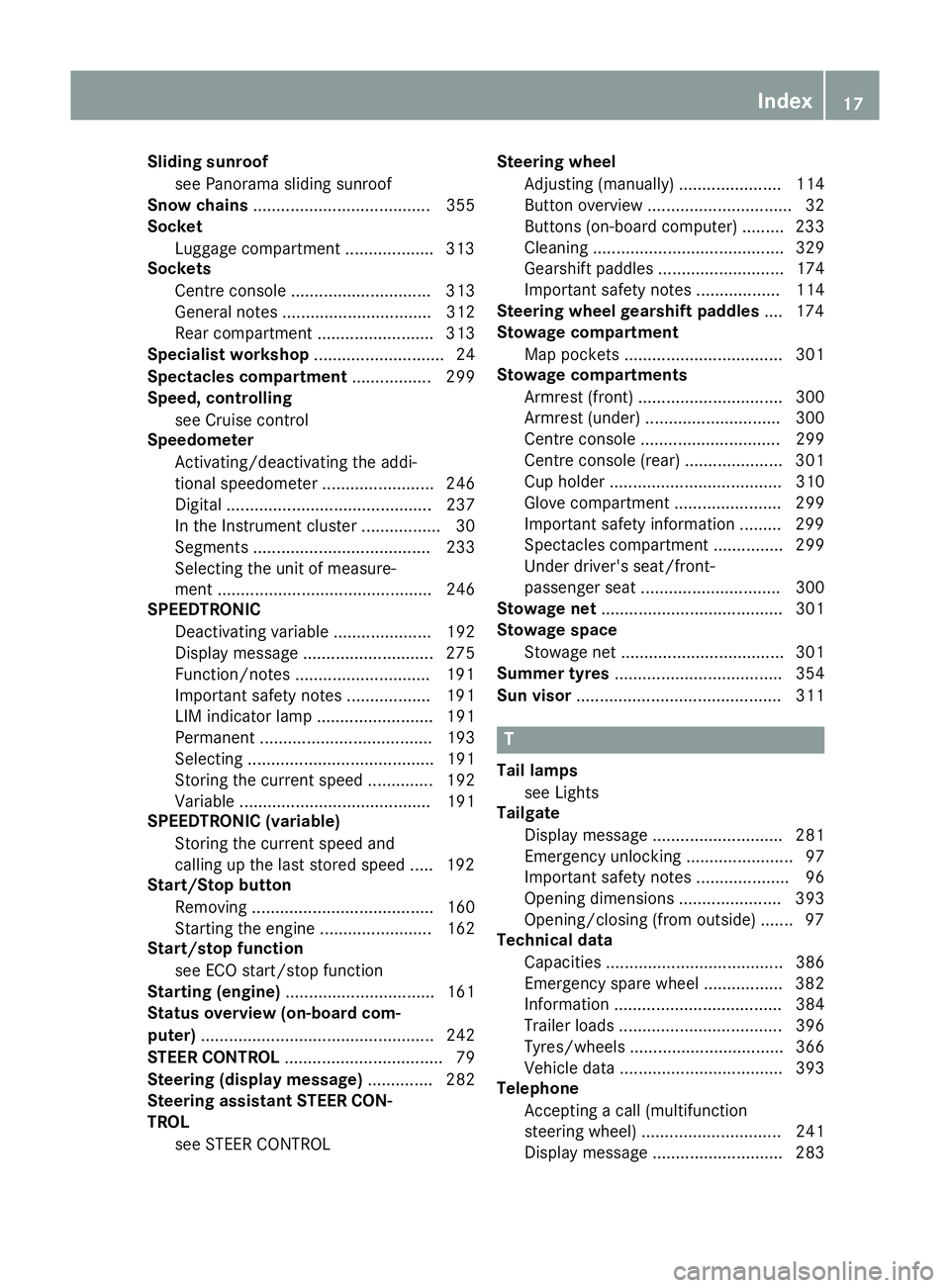
Sliding sunroof
see Panorama sliding sunroof
Snow chains ...................................... 355
Socket
Luggage compartment ...................3 13
Sockets
Centre console .............................. 313
General notes ................................ 312
Rear compartment ......................... 313
Specialist workshop ............................ 24
Spectacles compartment ................. 299
Speed, controlling
see Cruise control
Speedometer
Activating/deactivating the addi-
tional speedometer ........................ 246
Digital ............................................ 237
In the Instrument cluster ................. 30
Segments ...................................... 233
Selecting the unit of measure-
ment .............................................. 246
SPEEDTRONIC
Deactivating variable ..................... 192
Display message ............................ 275
Function/notes ............................ .191
Important safety notes .................. 191
LIM indicator lamp ......................... 191
Permanent ..................................... 193
Selecting ........................................ 191
Storing the current spee d.............. 192
Variabl e......................................... 191
SPEEDTRONIC (variable)
Storing the current speed and
calling up the last stored speed ..... 192
Start/Stop button
Removing ....................................... 160
Starting the engine ........................ 162
Start/stop function
see ECO start/stop function
Starting (engine) ................................ 161
Status overview (on-board com-
puter) .................................................. 242
STEER CONTROL .................................. 79
Steering (display message) .............. 282
Steering assistant STEER CON-
TROL
see STEER CONTROL Steering wheel
Adjusting (manually) ...................... 114
Button overview ............................... 32
Buttons (on-board computer) ......... 233
Cleaning ......................................... 329
Gearshift paddle s........................... 174
Important safety notes .................. 114
Steering wheel gearshift paddles .... 174
Stowage compartment
Map pockets .................................. 301
Stowage compartments
Armrest (front) ............................... 300
Armrest (under) ............................. 300
Centre console .............................. 299
Centre console (rear) ..................... 301
Cup holde r..................................... 310
Glove compartment ....................... 299
Important safety information ......... 299
Spectacles compartment ............... 299
Under driver's seat/front-
passenger sea t.............................. 300
Stowage net ....................................... 301
Stowage space
Stowage net ................................... 301
Summer tyres .................................... 354
Sun visor ............................................ 311 T
Tail lamps see Lights
Tailgate
Display message ............................ 281
Emergency unlocking ....................... 97
Important safety notes .................... 96
Opening dimensions ...................... 393
Opening/closing (from outside) ....... 97
Technical data
Capacities ...................................... 386
Emergency spare wheel ................. 382
Information .................................... 384
Trailer load s................................... 396
Tyres/wheels ................................. 366
Vehicle data ................................... 393
Telephone
Accepting a call (multifunction
steering wheel) .............................. 241
Display message ............................ 283 Index
17
Page 91 of 405
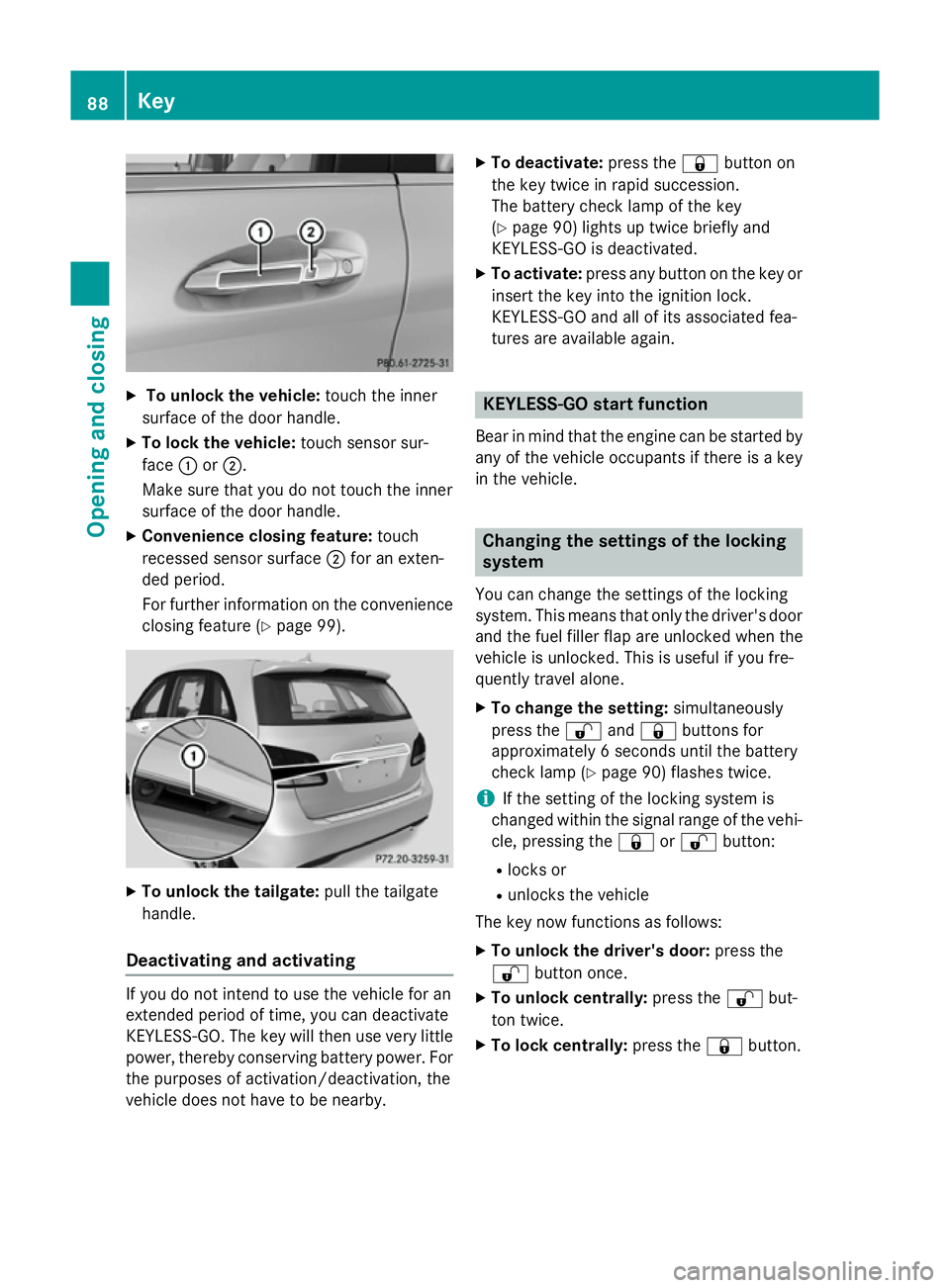
X
To unlock the vehicle: touch the inner
surface of the door handle.
X To lock the vehicle: touch sensor sur-
face :or;.
Make sure that you do not touch the inner
surface of the door handle.
X Convenience closing feature: touch
recessed sensor surface ;for an exten-
ded period.
For further information on the convenience closing feature (Y page 99).X
To unlock the tailgate: pull the tailgate
handle.
Deactivating and activating If you do not intend to use the vehicle for an
extended period of time, you can deactivate
KEYLESS-GO. The key will then use very little power, thereby conserving battery power. For
the purposes of activation/deactivation, the
vehicle does not have to be nearby. X
To deactivate: press the&button on
the key twice in rapid succession.
The battery check lamp of the key
(Y page 90) lights up twice briefly and
KEYLESS-GO is deactivated.
X To activate: press any button on the key or
insert the key into the ignition lock.
KEYLESS-GO and all of its associated fea-
tures are available again. KEYLESS-GO start function
Bear in mind that the engine can be started by any of the vehicle occupants if there is a key
in the vehicle. Changing the settings of the locking
system
You can change the settings of the locking
system. This means that only the driver's door and the fuel filler flap are unlocked when the
vehicle is unlocked. This is useful if you fre-
quently travel alone.
X To change the setting: simultaneously
press the %and& buttons for
approximately 6 seconds until the battery
check lamp (Y page 90) flashes twice.
i If the setting of the locking system is
changed within the signal range of the vehi- cle, pressing the &or% button:
R locks or
R unlocks the vehicle
The key now functions as follows:
X To unlock the driver's door: press the
% button once.
X To unlock centrally: press the%but-
ton twice.
X To lock centrally: press the&button. 88
KeyOpening and closing
Page 92 of 405
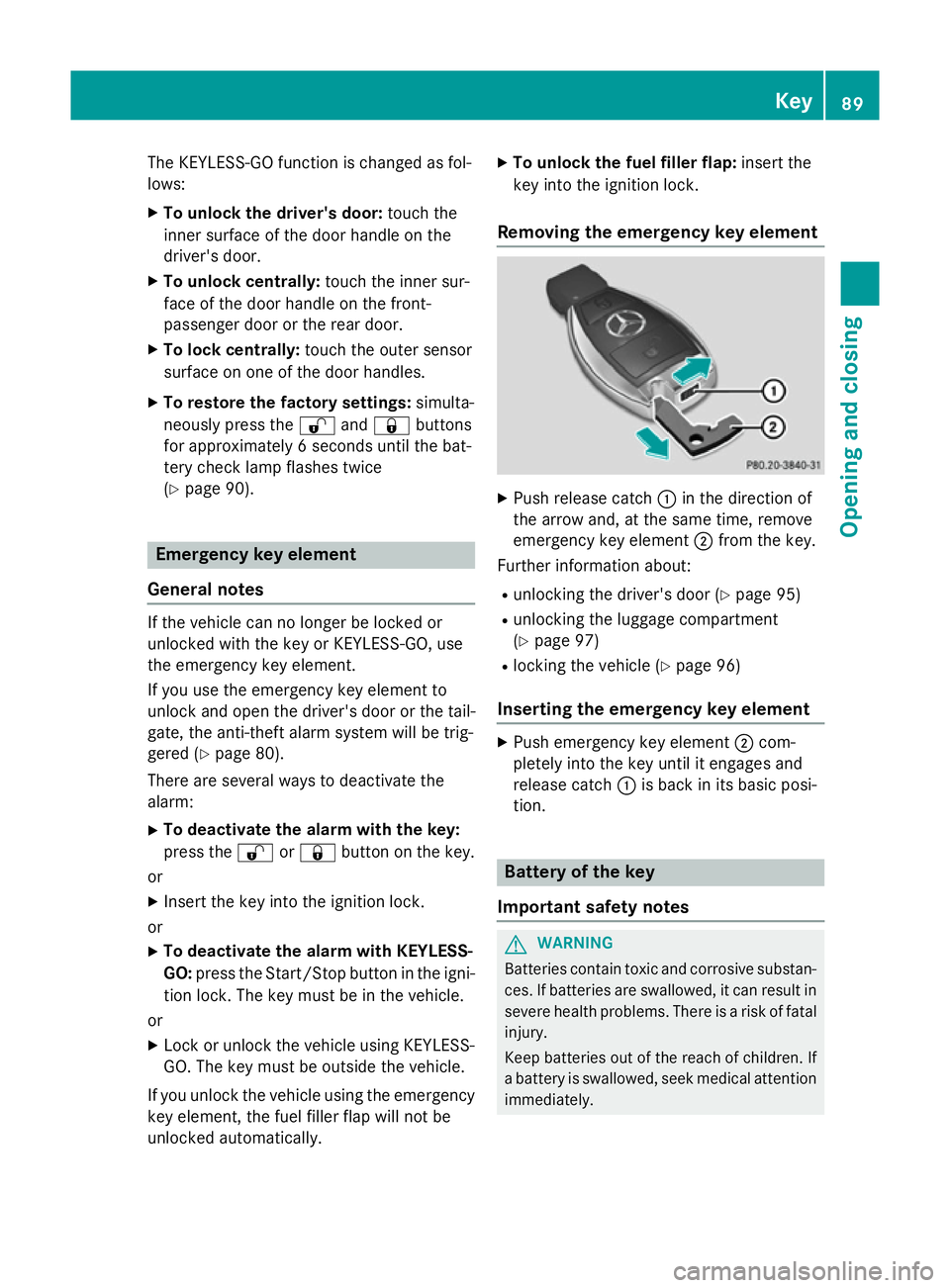
The KEYLESS-GO function is changed as fol-
lows:
X To unlock the driver's door: touch the
inner surface of the door handle on the
driver's door.
X To unlock centrally: touch the inner sur-
face of the door handle on the front-
passenger door or the rear door.
X To lock centrally: touch the outer sensor
surface on one of the door handles.
X To restore the factory settings: simulta-
neously press the %and& buttons
for approximately 6 seconds until the bat-
tery check lamp flashes twice
(Y page 90). Emergency key element
General notes If the vehicle can no longer be locked or
unlocked with the key or KEYLESS-GO, use
the emergency key element.
If you use the emergency key element to
unlock and open the driver's door or the tail-
gate, the anti-theft alarm system will be trig-
gered (Y page 80).
There are several ways to deactivate the
alarm:
X To deactivate the alarm with the key:
press the %or& button on the key.
or
X Insert the key into the ignition lock.
or
X To deactivate the alarm with KEYLESS-
GO: press the Start/Stop button in the igni-
tion lock. The key must be in the vehicle.
or
X Lock or unlock the vehicle using KEYLESS-
GO. The key must be outside the vehicle.
If you unlock the vehicle using the emergency
key element, the fuel filler flap will not be
unlocked automatically. X
To unlock the fuel filler flap: insert the
key into the ignition lock.
Removing the emergency key element X
Push release catch :in the direction of
the arrow and, at the same time, remove
emergency key element ;from the key.
Further information about:
R unlocking the driver's door (Y page 95)
R unlocking the luggage compartment
(Y page 97)
R locking the vehicle (Y page 96)
Inserting the emergency key element X
Push emergency key element ;com-
pletely into the key until it engages and
release catch :is back in its basic posi-
tion. Battery of the key
Important safety notes G
WARNING
Batteries contain toxic and corrosive substan- ces. If batteries are swallowed, it can result in
severe health problems. There is a risk of fatal injury.
Keep batteries out of the reach of children. If
a battery is swallowed, seek medical attention immediately. Key
89Opening and closing Z
Page 93 of 405
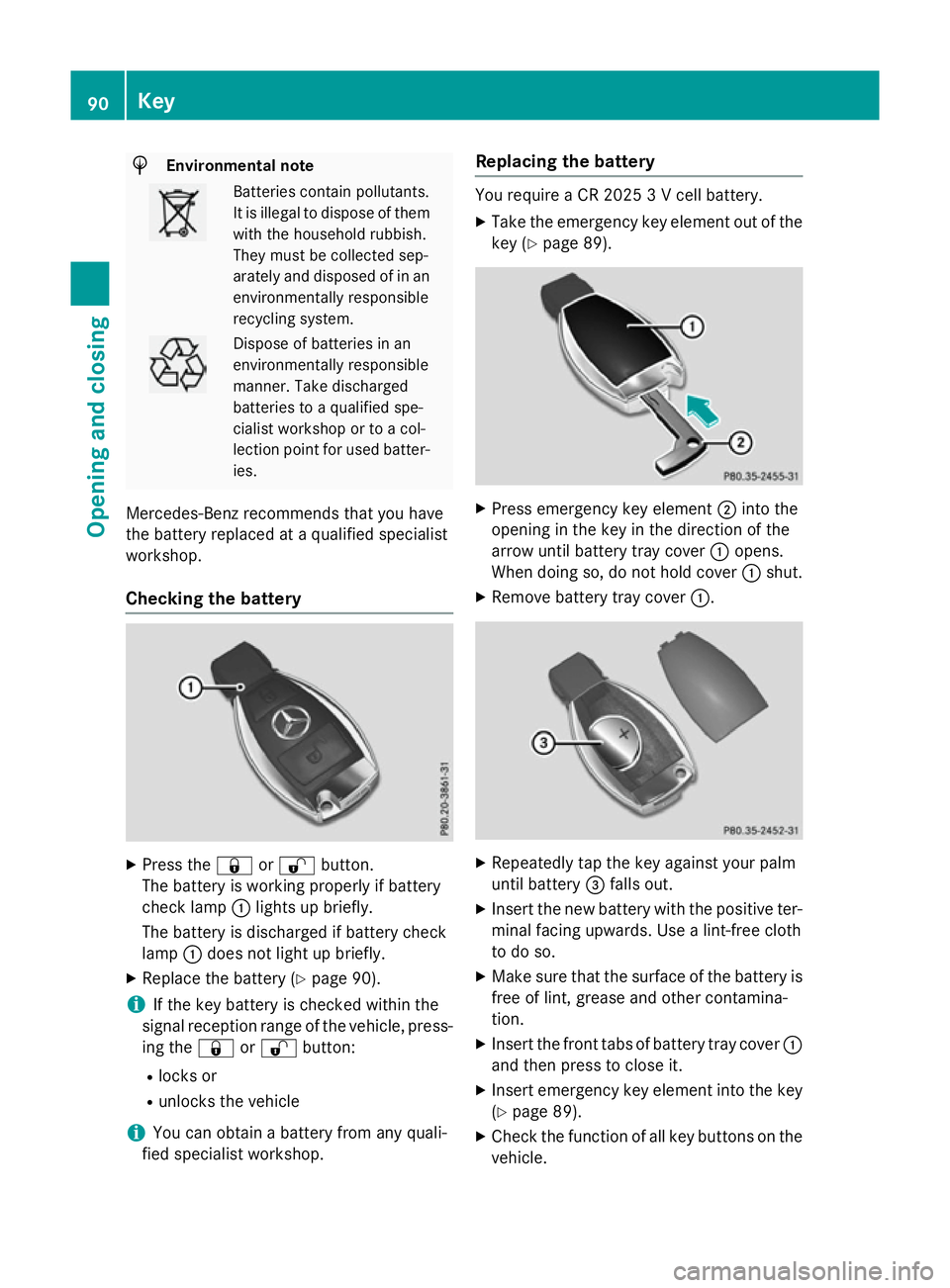
H
Environmental note Batteries contain pollutants.
It is illegal to dispose of them with the household rubbish.
They must be collected sep-
arately and disposed of in anenvironmentally responsible
recycling system. Dispose of batteries in an
environmentally responsible
manner. Take discharged
batteries to a qualified spe-
cialist workshop or to a col-
lection point for used batter-
ies.
Mercedes-Benz recommends that you have
the battery replaced at a qualified specialist
workshop.
Checking the battery X
Press the &or% button.
The battery is working properly if battery
check lamp :lights up briefly.
The battery is discharged if battery check
lamp :does not light up briefly.
X Replace the battery (Y page 90).
i If the key battery is checked within the
signal reception range of the vehicle, press- ing the &or% button:
R locks or
R unlocks the vehicle
i You can obtain a battery from any quali-
fied specialist workshop. Replacing the battery You require a CR 2025 3 V cell battery.
X Take the emergency key element out of the
key (Y page 89). X
Press emergency key element ;into the
opening in the key in the direction of the
arrow until battery tray cover :opens.
When doing so, do not hold cover :shut.
X Remove battery tray cover :. X
Repeatedly tap the key against your palm
until battery =falls out.
X Insert the new battery with the positive ter-
minal facing upwards. Use a lint-free cloth
to do so.
X Make sure that the surface of the battery is
free of lint, grease and other contamina-
tion.
X Insert the front tabs of battery tray cover :
and then press to close it.
X Insert emergency key element into the key
(Y page 89).
X Check the function of all key buttons on the
vehicle. 90
KeyOpening and closing
Page 98 of 405
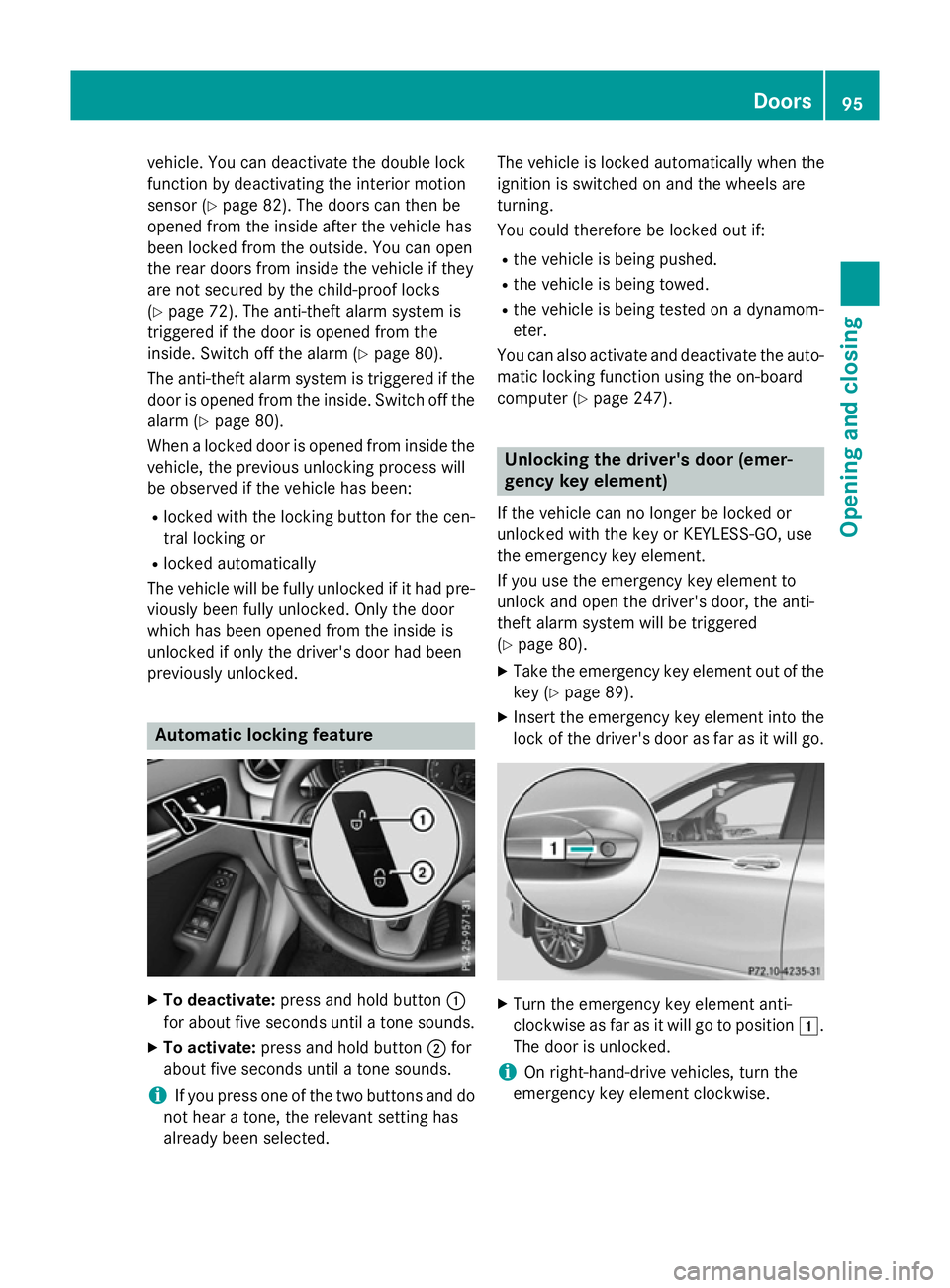
vehicle. You can deactivate the double lock
function by deactivating the interior motion
sensor (Y page 82). The doors can then be
opened from the inside after the vehicle has
been locked from the outside. You can open
the rear doors from inside the vehicle if they
are not secured by the child-proof locks
(Y page 72). The anti-theft alarm system is
triggered if the door is opened from the
inside. Switch off the alarm (Y page 80).
The anti-theft alarm system is triggered if the door is opened from the inside. Switch off the alarm (Y page 80).
When a locked door is opened from inside the vehicle, the previous unlocking process will
be observed if the vehicle has been:
R locked with the locking button for the cen-
tral locking or
R locked automatically
The vehicle will be fully unlocked if it had pre- viously been fully unlocked. Only the door
which has been opened from the inside is
unlocked if only the driver's door had been
previously unlocked. Automatic locking feature
X
To deactivate: press and hold button :
for about five seconds until a tone sounds.
X To activate: press and hold button ;for
about five seconds until a tone sounds.
i If you press one of the two buttons and do
not hear a tone, the relevant setting has
already been selected. The vehicle is locked automatically when the
ignition is switched on and the wheels are
turning.
You could therefore be locked out if:
R the vehicle is being pushed.
R the vehicle is being towed.
R the vehicle is being tested on a dynamom-
eter.
You can also activate and deactivate the auto- matic locking function using the on-board
computer (Y page 247). Unlocking the driver's door (emer-
gency key element)
If the vehicle can no longer be locked or
unlocked with the key or KEYLESS-GO, use
the emergency key element.
If you use the emergency key element to
unlock and open the driver's door, the anti-
theft alarm system will be triggered
(Y page 80).
X Take the emergency key element out of the
key (Y page 89).
X Insert the emergency key element into the
lock of the driver's door as far as it will go. X
Turn the emergency key element anti-
clockwise as far as it will go to position 1.
The door is unlocked.
i On right-hand-drive vehicles, turn the
emergency key element clockwise. Doors
95Opening and closing Z
Page 112 of 405
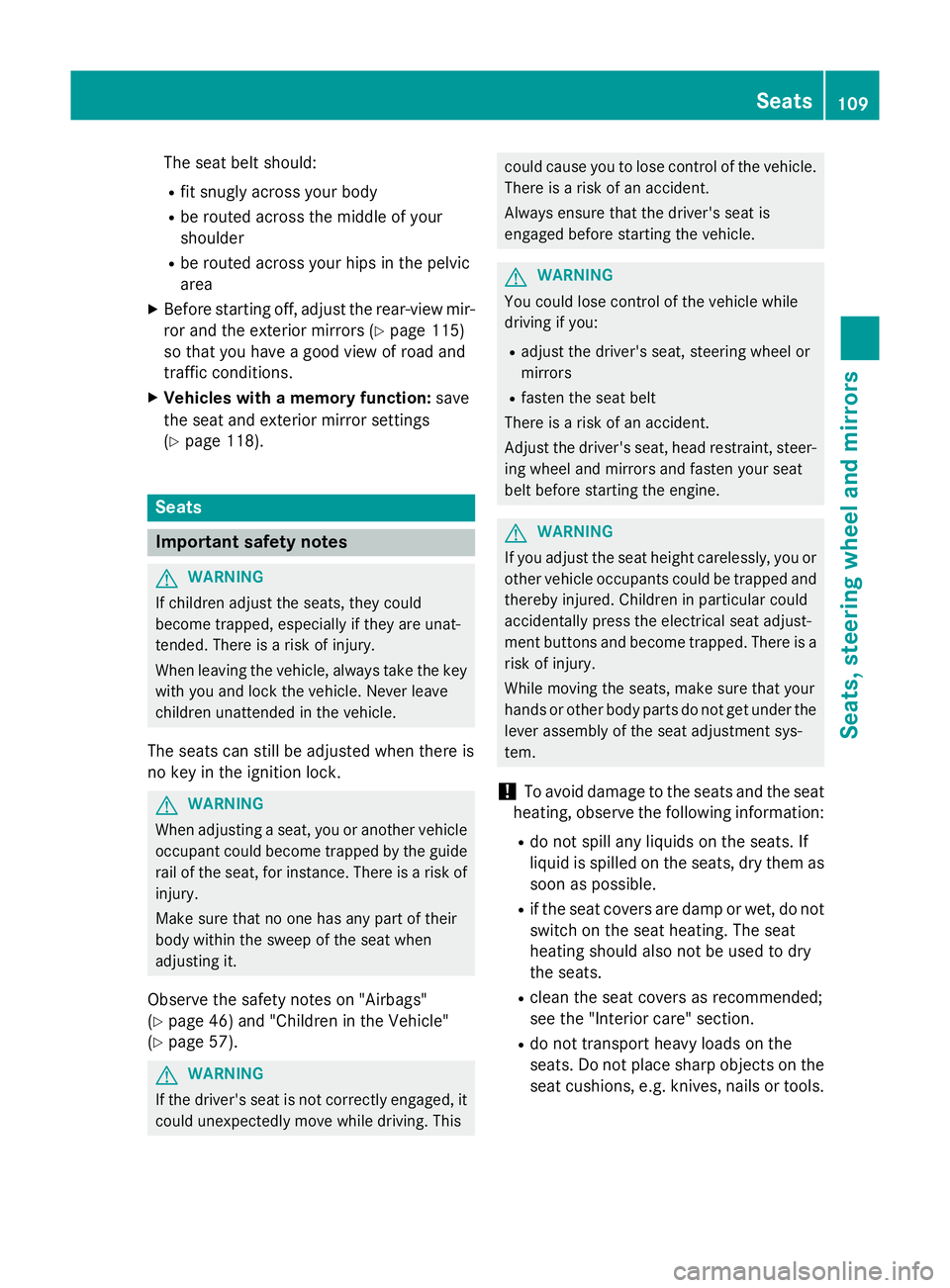
The seat belt should:
R fit snugly across your body
R be routed across the middle of your
shoulder
R be routed across your hips in the pelvic
area
X Before starting off, adjust the rear-view mir-
ror and the exterior mirrors (Y page 115)
so that you have a good view of road and
traffic conditions.
X Vehicles with a memory function: save
the seat and exterior mirror settings
(Y page 118). Seats
Important safety notes
G
WARNING
If children adjust the seats, they could
become trapped, especially if they are unat-
tended. There is a risk of injury.
When leaving the vehicle, always take the key with you and lock the vehicle. Never leave
children unattended in the vehicle.
The seats can still be adjusted when there is
no key in the ignition lock. G
WARNING
When adjusting a seat, you or another vehicle occupant could become trapped by the guiderail of the seat, for instance. There is a risk of
injury.
Make sure that no one has any part of their
body within the sweep of the seat when
adjusting it.
Observe the safety notes on "Airbags"
(Y page 46) and "Children in the Vehicle"
(Y page 57). G
WARNING
If the driver's seat is not correctly engaged, it could unexpectedly move while driving. This could cause you to lose control of the vehicle.
There is a risk of an accident.
Always ensure that the driver's seat is
engaged before starting the vehicle. G
WARNING
You could lose control of the vehicle while
driving if you:
R adjust the driver's seat, steering wheel or
mirrors
R fasten the seat belt
There is a risk of an accident.
Adjust the driver's seat, head restraint, steer-
ing wheel and mirrors and fasten your seat
belt before starting the engine. G
WARNING
If you adjust the seat height carelessly, you or other vehicle occupants could be trapped andthereby injured. Children in particular could
accidentally press the electrical seat adjust-
ment buttons and become trapped. There is a
risk of injury.
While moving the seats, make sure that your
hands or other body parts do not get under the
lever assembly of the seat adjustment sys-
tem.
! To avoid damage to the seats and the seat
heating, observe the following information:
R do not spill any liquids on the seats. If
liquid is spilled on the seats, dry them as
soon as possible.
R if the seat covers are damp or wet, do not
switch on the seat heating. The seat
heating should also not be used to dry
the seats.
R clean the seat covers as recommended;
see the "Interior care" section.
R do not transport heavy loads on the
seats. Do not place sharp objects on the
seat cushions, e.g. knives, nails or tools. Seats
109Seats, steering wheel and mirrors Z
Page 144 of 405
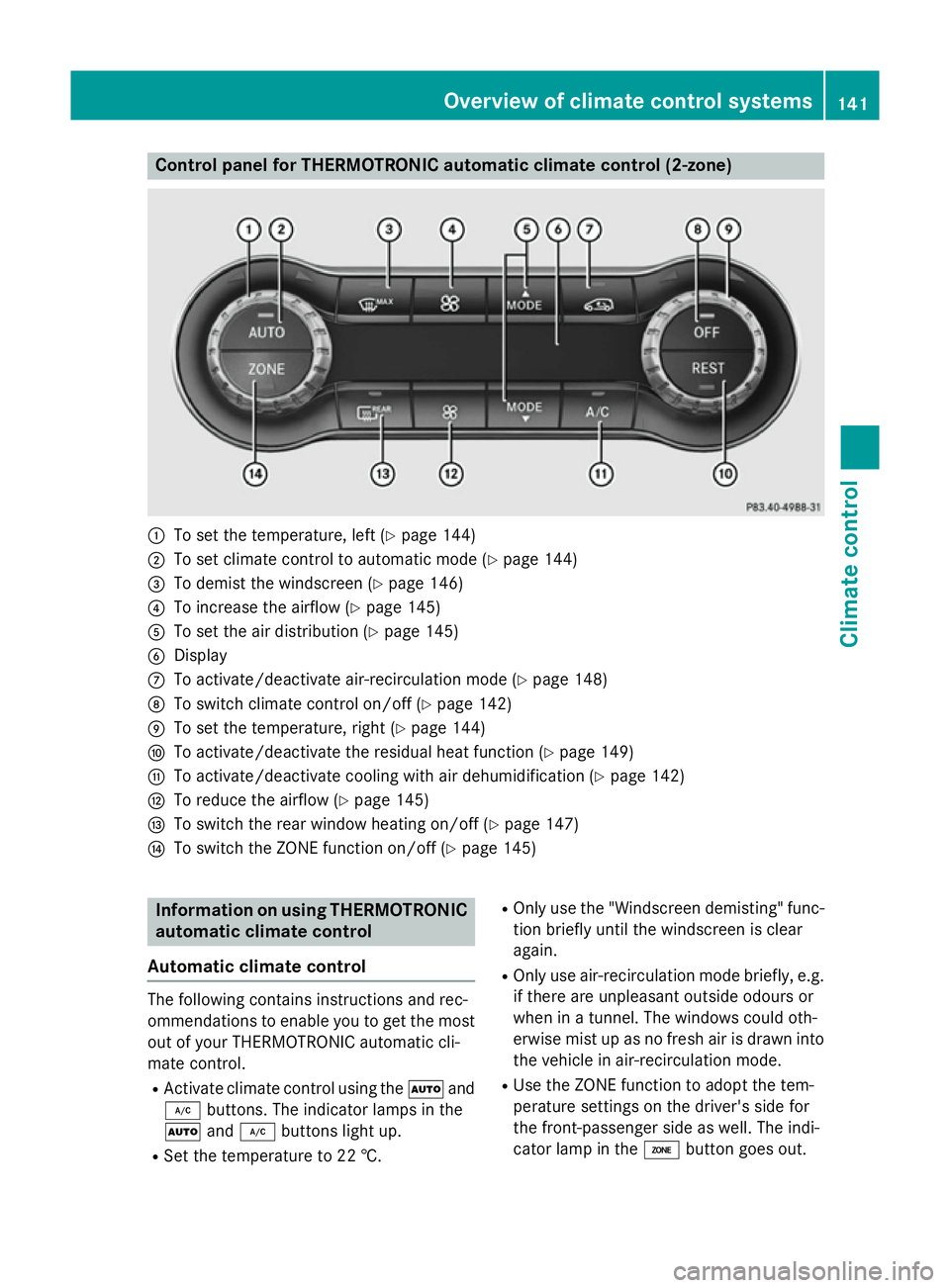
Control panel for THERMOTRONIC automatic climate control (2-zone)
:
To set the temperature, left (Y page 144)
; To set climate control to automatic mode (Y page 144)
= To demist the windscreen (Y page 146)
? To increase the airflow (Y page 145)
A To set the air distribution (Y page 145)
B Display
C To activate/deactivate air-recirculation mode (Y page 148)
D To switch climate control on/off (Y page 142)
E To set the temperature, right (Y page 144)
F To activate/deactivate the residual heat function (Y page 149)
G To activate/deactivate cooling with air dehumidification (Y page 142)
H To reduce the airflow (Y page 145)
I To switch the rear window heating on/off (Y page 147)
J To switch the ZONE function on/off (Y page 145)Information on using THERMOTRONIC
automatic climate control
Automatic climate control The following contains instructions and rec-
ommendations to enable you to get the most
out of your THERMOTRONIC automatic cli-
mate control.
R Activate climate control using the Ãand
¿ buttons. The indicator lamps in the
à and¿ buttons light up.
R Set the temperature to 22 †. R
Only use the "Windscreen demisting" func-
tion briefly until the windscreen is clear
again.
R Only use air-recirculation mode briefly, e.g.
if there are unpleasant outside odours or
when in a tunnel. The windows could oth-
erwise mist up as no fresh air is drawn into the vehicle in air-recirculation mode.
R Use the ZONE function to adopt the tem-
perature settings on the driver's side for
the front-passenger side as well. The indi-
cator lamp in the ábutton goes out. Overview of climate control systems
141Climate control
Page 148 of 405

Only change the temperature setting in
small increments. Start at 22 †.
Setting the air distribution
Air-conditioning system Air distribution settings
¯
Directs the airflow through the demis-
ter vents
P Directs the airflow through the centre
and side air vents
O Directs the airflow through the foot-
well air vents
i You can also activate several of the air
distribution settings simultaneously. In
order to do this, press several of the air
distribution buttons. The air is then routed
through different air vents.
i Regardless of the air distribution setting,
airflow is always directed through the side
air vents. The side air vents can only be
closed if the adjusters are turned clockwise until they engage.
Setting the air distribution X Turn the key to position 2in the ignition
lock (Y page 159).
X Press one or more of the P,O,¯
buttons.
The corresponding indicator lamp comes
on.
THERMOTRONIC automatic climate
control Air distribution settings
¯
Directs the airflow through the demis-
ter vents
P Directs the airflow through the centre
and side air vents
O Directs the airflow through the foot-
well air vents S
Directs the airflow through the centre
and side air vents as well as the foot-
well air vents
b Directs the airflow through the centre
and side air vents as well as the demis-
ter vents
a Directs the airflow through the foot-
well and demister vents
_ Directs the airflow through the demis-
ter vents, the centre and side air vents
as well as the footwell air vents
i Regardless of the air distribution setting,
airflow is always directed through the side
air vents. The side air vents can only be
closed if the adjusters are turned clockwise until they engage.
Setting the air distribution
X Turn the key to position 2in the ignition
lock (Y page 159).
X Press the ÉorË button repeatedly
until the desired symbol appears in the dis- play. Setting the airflow
Air-conditioning system X
Turn the key to position 2in the ignition
lock (Y page 159).
X To increase/reduce: turn controlAanti-
clockwise or clockwise (Y page 139).
THERMOTRONIC automatic climate
control X
Turn the key to position 2in the ignition
lock (Y page 159).
X To increase/reduce: press theKor
I button. Switching the ZONE function on/off
This function is only available with
THERMOTRONIC automatic climate control. Operating the climate control system
145Climate control
Page 236 of 405
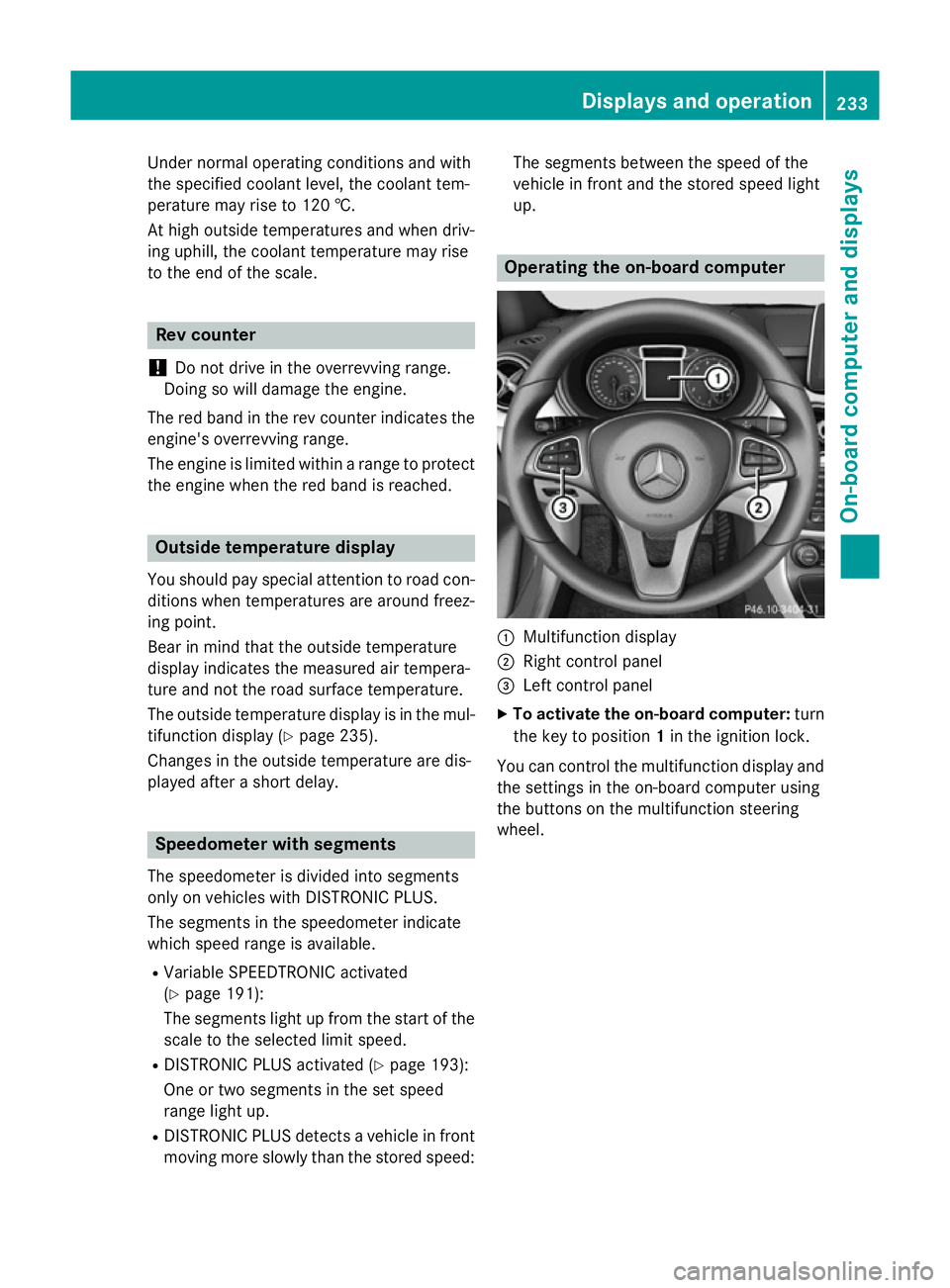
Under normal operating conditions and with
the specified coolant level, the coolant tem-
perature may rise to 120 †.
At high outside temperatures and when driv-
ing uphill, the coolant temperature may rise
to the end of the scale. Rev counter
! Do not drive in the overrevving range.
Doing so will damage the engine.
The red band in the rev counter indicates the
engine's overrevving range.
The engine is limited within a range to protect the engine when the red band is reached. Outside temperature display
You should pay special attention to road con-
ditions when temperatures are around freez-
ing point.
Bear in mind that the outside temperature
display indicates the measured air tempera-
ture and not the road surface temperature.
The outside temperature display is in the mul- tifunction display (Y page 235).
Changes in the outside temperature are dis-
played after a short delay. Speedometer with segments
The speedometer is divided into segments
only on vehicles with DISTRONIC PLUS.
The segments in the speedometer indicate
which speed range is available.
R Variable SPEEDTRONIC activated
(Y page 191):
The segments light up from the start of the
scale to the selected limit speed.
R DISTRONIC PLUS activated (Y page 193):
One or two segments in the set speed
range light up.
R DISTRONIC PLUS detects a vehicle in front
moving more slowly than the stored speed: The segments between the speed of the
vehicle in front and the stored speed light
up. Operating the on-board computer
:
Multifunction display
; Right control panel
= Left control panel
X To activate the on-board computer: turn
the key to position 1in the ignition lock.
You can control the multifunction display and
the settings in the on-board computer using
the buttons on the multifunction steering
wheel. Displays and operation
233On-board computer and displays Z